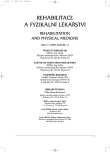-
Medical journals
- Career
Aimed Electric Stimulation and Its Influence on Distant Muscular Groups
Authors: D. Pánek; Š. Horáčková; R. Bendová; N. Merker; M. Mezsárošová; D. Pavlů
Authors‘ workplace: Fakulta tělesné výchovy a sportu UK, katedra fyzioterapie, Praha, vedoucí katedry PaeDr. D. Pavlů, CSc.
Published in: Rehabil. fyz. Lék., 12, 2005, No. 1, pp. 41-44.
Category: Original Papers
Overview
Electric stimulation belongs to routinely used methods in physical medicine. It has been also used, over the last years, in research to evoke so called “artificial spasm”. There are reports dealing with EMG changes in stimulated muscles, but no reports were found which would deal with possible effects on distant muscles. In this pilot study the authors attempted to obtain basal information on the effect of electric stimulation on the stimulated muscle and distant muscular groups and, also, to verify, whether the response depends on the type of current and its frequency. The stimulation was mediated by the Neuroton 926 device at the position of motor point of m. biceps brachii l.dx. by low-frequency TENS surge current on the frequency of 10–30 Hz, 50 Hz, 30–60 Hz and 100–200 Hz and by the medium frequency current with frequency modulation of 50 Hz, 62.5 Hz, 90 Hz and 142 Hz, respectively. The surface polyEMG Noraxon device was used to record electric response in the course of stimulation in both of m. biceps brachii, m. tricept brachii, m. trapezium, m. tibialis, m. biceps femoris and m. peroneus longus. The EMG records obtained were subsequently processed by means of Fourier rapid transformation and the results were evaluated visually.
Key words:
electric stimulation, EMG
Labels
Physiotherapist, university degree Rehabilitation Sports medicine
Article was published inRehabilitation & Physical Medicine

2005 Issue 1-
All articles in this issue
- OUTFLARE – INFLARE – a Change in Position of the Pelvis
- Myalgia and Deviation’s of the Spine Axis
- Some Theoretical Remarks t o the Problems o f Open and Closed Biomechanic Chains
- Open and Closed Biomechanical Chains in Kinesiologic Therapeutic Practice
- Influence of Afferent Inputs on the Neurological Signs in Patients with Radicular Symptomatology
- Effect of Cycling on Locomotor System
- Rehabilitation of Sphincter and Destrusor Bladder Control Reflex after Injuries to Spinal Cord Using Electr onic Regulator of Flow
- Aimed Electric Stimulation and Its Influence on Distant Muscular Groups
- Relation of Headache to Painful Muscular Spasms
- Aplication of the Period of Plaster Fixation of Inborn Defects of Lower Extremities for Rehabilitation
- Rehabilitation & Physical Medicine
- Journal archive
- Current issue
- Online only
- About the journal
Most read in this issue- OUTFLARE – INFLARE – a Change in Position of the Pelvis
- Open and Closed Biomechanical Chains in Kinesiologic Therapeutic Practice
- Some Theoretical Remarks t o the Problems o f Open and Closed Biomechanic Chains
- Relation of Headache to Painful Muscular Spasms
Login#ADS_BOTTOM_SCRIPTS#Forgotten passwordEnter the email address that you registered with. We will send you instructions on how to set a new password.
- Career

